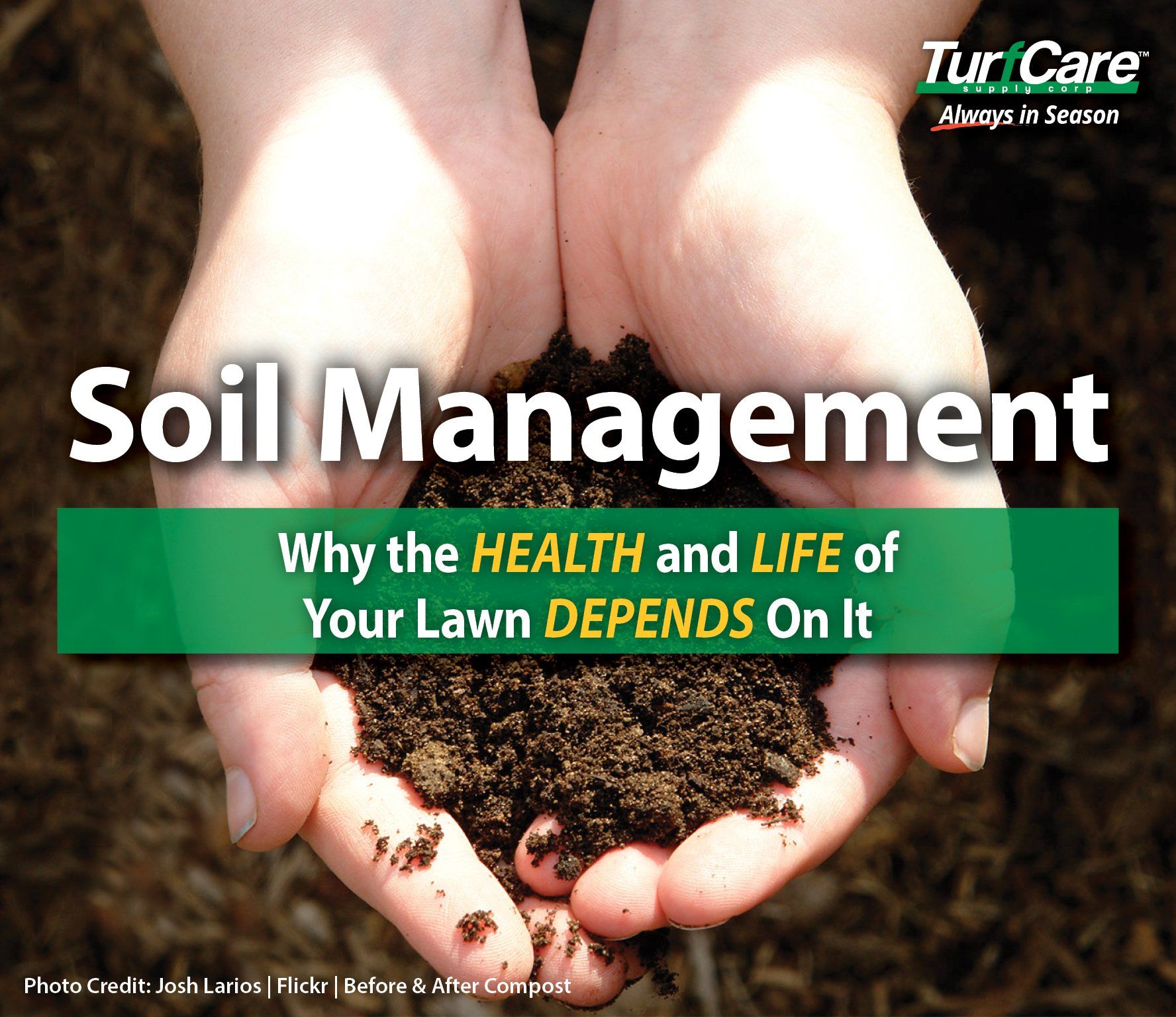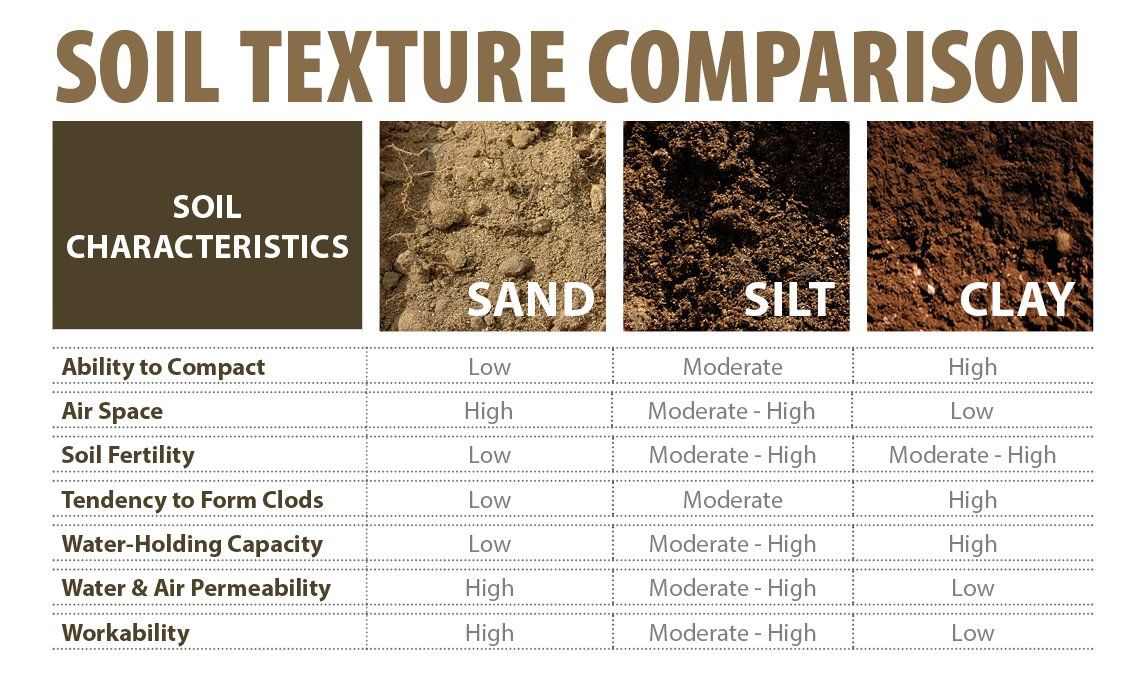SOIL MANAGEMENT

- Sand: Soil with the largest mineral particles. Sand particles create large pore spaces that help improve aeration and water drainage. Soil with a high percentage of sand will generally be well drained but will lack the ability to retain key nutrients, impacting soil fertility.
- Silt: Soil with mid-sized soil particles. Silt is an ideal soil type to have for its water retention abilities and soil fertility characteristics.
- Clay: Soil with the smallest mineral size. Although it can retain moisture well, clay soil creates very small pore spaces, causing poor water drainage and aeration. Clay also compacts easily, making it difficult for plant roots to grow.

SOIL STRUCTURE Soil structure refers to the arrangement and combination of soil particles (peds) into aggregates, or clusters of various shapes and sizes that are bound together by physical, chemical and biological processes (fungal activity, tilling, freezing, thawing, wetting, drying, and by plant root growth). Aggregates that are naturally formed in soil are known as peds while the clumps formed from tilling and working the soil are called clods. Like soil texture, the structure of soil is important because it affects:
- Water and Air Flow through Soil
- Nutrient Availability for Plant Uptake
- Root growth
- Sustaining Biological Diversity, Activity and Productivity
- Filtering of Organic and Inorganic Materials
- Erosion Prevention
- Compaction Prevention
- Runoff Prevention of Fertilizers, Pesticides and Other Pollutants into Waterways
The size, shape and strength of aggregates determine the spaces between them (aggregates) called pores. Pore structure affects how easily roots, water and air move through soil. Pore spaces that have a range of sizes, including both large pores between aggregates and small pores within the aggregates, allow for more water, air and nutrient movement, better root growth, water retention as well as passageways for microorganisms. For example, sandy soils have low aggregation so roots and water move readily through soil, while clay soil has high aggregation, making it a little more challenging for water and roots to move through soil.
SOIL QUALITY
Understanding and monitoring soil texture and structure are important steps into managing soil quality. Soils are complex, diverse and have the potential to be greatly altered to improve your plant or lawns growing environment. By focusing on feeding your soil, you can enhance your plant/lawn health and durability. The best way to monitor your soil is to conduct a soil test to determine soil fertility, pH, and composition.
- NOTE: You can pick up a soil test kit at your local home and garden store or you can check with your local cooperative extension office to see if they do soil testing.
HOW TO IMPROVE SOIL QUALITY
Once you make an assessment of the lawn’s soil and its conditions, you can decide what efforts you can make to enhance the quality of your lawns growing environment. Beneficial improvements you can add to your lawn care routine to help manage soil quality include:
- Aeration: Aeration helps manage soil that can be easily compacted. Compaction inhibits root growth, water availability and air flow. This also allows earthworms and other microorganisms to roam freely, keeping soil healthy and fertile.
- Adopt a Lawn Care Program: Add additional nutrients to your soil with fertilizers. Refer to your soil test for appropriate recommendations for your soil. Read all product label instructions for proper rate of application and timing.
- Apply a Soil Amendment: Soil amendments have the ability to enhance a soil’s structure, water retention, permeability and drainage properties as well as balancing its chemical properties (pH and nutrient availability status).
- Introduce Microbes: Microbes help to improve soil structure by stabilizing soil aggregates as well as turn organic matter into nutrients plants can absorb like nitrogen, phosphorus , potassium, oxygen, hydrogen and other essential minerals needed for plant growth.
- Minimizing Lawn Traffic: This includes both foot and vehicle traffic. Heavy foot traffic and vehicles driving or parking on grass (including mowers) can cause compaction. Refrain from allowing vehicles on your lawn and try to use designated walkways when possible. TIP: Although mowers can cause your lawns soil to compact, try to vary your mowing patterns in order to slow compaction.
- Till Area: Tilling you soil is great for starting new lawns or lawn renovations because it breaks up hard, dense subsoil, clods, and soil crust. Tilling will also help level your lawn, preventing water from puddling by promoting proper drainage. TIP: Rototillers are great for areas that are too large or hard to dig. Never till when your soil is wet.
For more information on our Soil Amendments, Click Here.
For green industry professionals or others interested in ordering Turfcare products, please contact our Customer Service to find a distributor near you.
The TURFReport Highlights:
Additional Articles and Insights
















